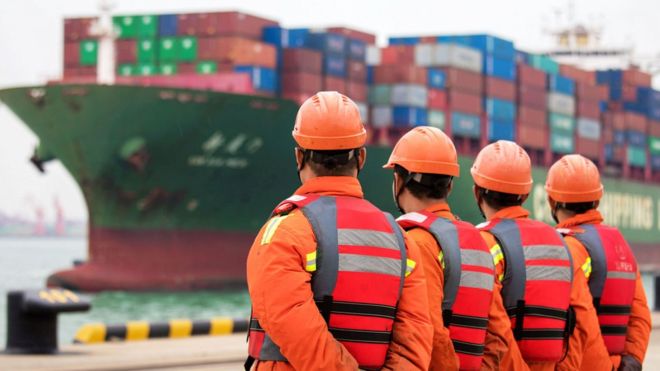China’s exports unexpectedly fell in August as shipments to the US slowed sharply, adding to worries about the effects of the two nations’ trade war.
China is expected to announce more support measures soon, to avert the risk of a sharp economic slowdown.
These could include the first cuts in four years to some key lending rates.
August exports from the world’s second largest economy fell 1% from a year earlier, the biggest fall since June, when they fell 1.3%,
Analysts had expected to see a rise in exports.
‘Sluggish demand’
China’s August exports to the US fell 16% year-on-year, slowing sharply from a decline of 6.5% in July. Meanwhile, imports from the US slumped 22.4%.
There were escalations in August in the year-long trade row, with Washington announcing 15% tariffs on a wide range of Chinese goods from September.
China hit back with levies of its own, and let its yuan currency fall to offset some of the tariff pressures.
On Friday, China’s central bank cut banks’ reserve requirements for a seventh time since early 2018 to free up more funds for lending.
Analyst expectations had been that a falling yuan would offset some cost pressures.
China let its currency slide past the key 7-per-dollar level in August for the first time since the global financial crisis.
That led Washington to dub Beijing “a currency manipulator”.
“Exports are still weak even in the face of substantial yuan currency depreciation, indicating that sluggish external demand is the most important factor affecting exports this year,” said Zhang Yi, economist at Zhong Hai Sheng Rong Capital Management.
Fresh talks
Many analysts expect export growth to slow further in coming months, with more US tariff measures due to take effect on 1 October and 15 December.
Chinese exports to Europe, South Korea, Australia, and South East Asia also worsened on an annual basis, compared with July.
But exports to Japan and Taiwan were slightly better than the previous month.
On Thursday, China and the US agreed to renew trade talks in October in Washington, the first since a failed US-China trade meeting in July.

